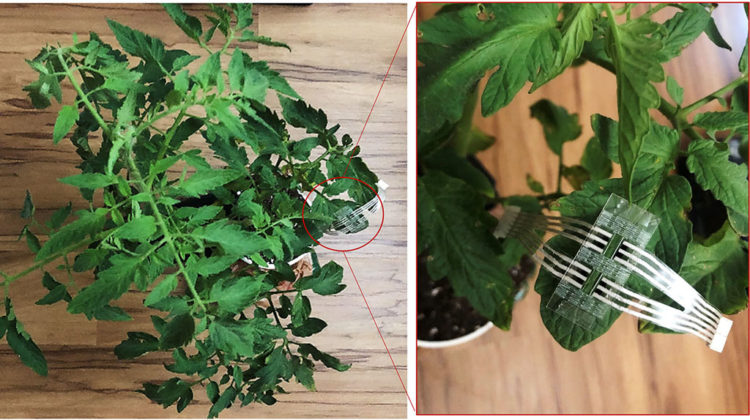
A team of researchers at North Carolina State University has developed a sensor that continuously monitors the plant to which it’s attached for disease and other stressors, such as physical damage or extreme heat.
‘We’ve created a wearable sensor that monitors plant stress and disease in a non-invasive way by measuring the volatile organic compounds (VOCs) emitted by plants,’ said Qingshan Wei, an assistant professor of chemical and biomolecular engineering at NC State who worked on the project.
Currently, testing plants for stress or the presence of disease involves taking tissue samples and conducting lab assays. However, this only provides a snapshot of the situation at the time the sample was taken, which may be some time before the results come in.
Plants emit a range of different combinations of VOCs, depending on the environmental conditions affecting them.The new sensors can be tuned to detect VOCs that are released when the plants are infected by specific diseases, enabling growers to react quickly.
‘Our technology monitors VOC emissions from the plant continuously, without harming the plant,’ Wei said. ‘The prototype we’ve demonstrated stores this monitoring data, but future versions will transmit the data wirelessly. What we’ve developed allows growers to identify problems in the field – they wouldn’t have to wait to receive test results from a lab.’
The 30-millimetre-long rectangular patches are made from a flexible material that contains graphene-based sensors and flexible silver nanowires.The sensors are coated with various chemical ligands that respond to the presence of specific VOCs, allowing the system to detect and measure VOCs in gases emitted by the plant’s leaves.
The researchers tested a prototype designed to detect two types of stress – physical damage and infection by Phytophthora infestans, the pathogen that causes late blight disease – on tomato plants.The system detected VOC changes associated with physical damage within one to three hours, depending on the distance of the damage from the patch. It took longer for the sensors to detect the presence of P. infestans – roughly three to four days after researchers had inoculated the tomato plants.
‘This is not markedly faster than the appearance of visual symptoms of late blight disease,’ Wei says. ‘However, the monitoring system means growers don’t have to rely on detecting minute visual symptoms. Continuous monitoring would allow growers to identify plant diseases as quickly as possible, helping them limit the spread of the disease.’
‘Our prototypes can already detect 13 different plant VOCs with high accuracy, allowing users to develop a customised sensor array that focuses on the stresses and diseases that a grower thinks are most relevant,’ said Yong Zhu, Andrew A Adams distinguished professor of mechanical and aerospace engineering at NC State, who also worked on the project.
‘It’s also important to note that the materials are fairly low cost,’ Zhu says. ‘If the manufacturing was scaled up, we think this technology would be affordable. We’re trying to develop a practical solution to a real-world problem, and we know cost is an important consideration.’
The researchers are now developing a next-generation solar-powered patch that can monitor temperature, humidity and other environmental variables as well as VOCs.
The research has been published in the journal Matter.


